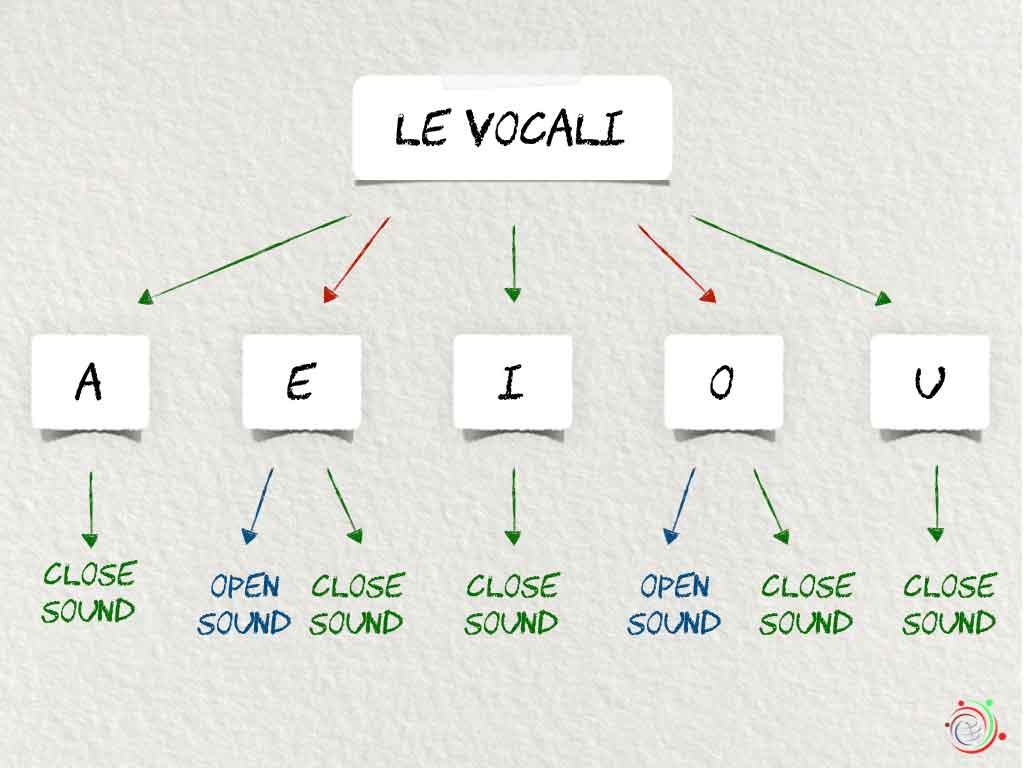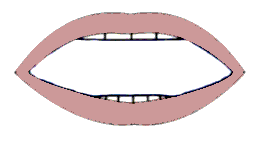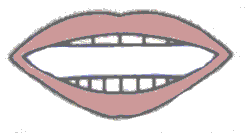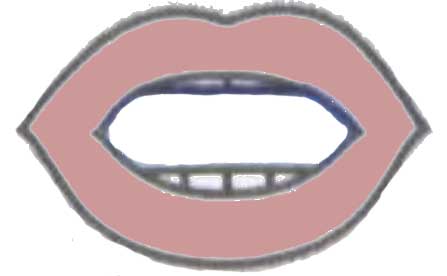Italian pronunciation could be quite difficult at the beginning but once the rules are understood it is easy to pronounce each word correctly. In this article, you’ll find an easy guide to Italian vowel pronunciation,
OVERVIEW of Italian vowel pronunciation
The Italian language has 7 vowel sounds and 20 consonant sounds.
Each letter or combination of letters usually stands for only one distinct sound.
Italians pronounce each syllable clearly and separately and pronounce the syllables evenly.
Vowels – Five vowels but seven sounds

Le vocali sono suoni che sono pronunciati quando facciamo uscire l’aria dalla bocca. In base alla maggiore o minore apertura della labbra, le vocali si distinguono in aperte e chiuse. (Vowels are sounds that we pronounce when we let the air out of the mouth. According to the greater or lesser opening of the lips, we divide the vowels into open and closed.)

Apri le labbra (open your lips)
Vowel A
Ha sempre un suono aperto. (It always has an open sound.)
Per pronunciare questa vocale, la lingua deve essere piatta e le labbra sono molto aperte. (To pronounce this vowel the tongue must be flat and the lips are very open.)
🎧 AUDIO
amare (to love)
arancia (orange)

Stendi le labbra (stretch your lips)
Vowel I
Ha sempre un suono chiuso. (It always has a close sound.)
Per pronunciare questa vocale, la lingua deve essere avanti e le labbra distese. (To pronounce this vowel, the tongue must be forward and the lips extended.)
🎧 AUDIO
isola (island)
inverno (winter)
Italia (Italy)

Stendi e apri un po’ le labbra (Stretch and open your lips a little)
Vowel E close
Per pronunciare questa vocale, la lingua deve essere in basso e le labbra un po’ distese e aperte. (To pronounce this vowel, place your tongue down and the lips somewhat extended and parted.)
🎧 AUDIO
elefante (elephant)
pera (pear)
seme (seed)

Stendi e apri un po’ le labbra (Stretch and open your lips a little)
Vowel E open
Per pronunciare questa vocale, la lingua deve essere in basso e le labbra un po’ distese e aperte. (To pronounce this vowel, place your tongue down and the lips somewhat extended and parted.)
🎧 AUDIO
erba (grass)
testa (head)
bene (well)

Arrotonda le labbra (Stretch and open your lips a little)
Vowel U
Ha sempre un suono chiuso. (It always has a close sound.)
Per pronunciare questa vocale, le labbra sono molto arrotondate. (To pronounce this vowel the lips are very rounded.)
🎧 AUDIO
uva (grapes)
uno (one)
uovo (egg)

Arrotonda un po’ le labbra (Stretch your lips a little)
Vowel O open
Per pronunciare questa vocale, le labbra sono un po’ arrotondate. (To pronounce this vowel, the lips are rounded a little.)
🎧 AUDIO
cuore (heart)
ruota (wheel)
scuola (school)

Arrotonda e apri un po’ le labbra (Stretch and open your lips a little)
Vowel O close
Per pronunciare questa vocale, la lingua deve essere in basso e le labbra un po’ distese e aperte. (To pronounce this vowel, place your tongue down and the lips somewhat extended and parted.)
🎧 AUDIO
voce (voice)
polso (wrist)
onda (wave)
Ci sono quindi 5 vocali ma 7 suoni perchè le 2 vocali E e O hanno hanno la stessa grafia ma si pronunciano diversamente. (With this easy guide to Italian vowel pronunciation you have learnt that there are therefore 5 vowels but 7 sounds because the 2 vowels E and O have the same spelling but are pronounced differently.)
Le parole con un accento grave (è) hanno un suono chiuso, mentre l’accento acuto (é) significa un suono aperto. Nella lingua scritta in realtà l’accento viene indicato solo quando è alla fine della parola. (Words with a grave accent (é / è) have a closed sound, while the acute accent (é / è) means an open sound. However, when spelt, words don’t use the accent (except when the accent is at the end of the word).
Non ci sono regole ferree per i suoni aperti o chiusi. In caso di difficoltà è necessario consultare il dizionario. (There are no hard and fast rules for open or closed sounds. In case of difficulty, it is necessary to consult the dictionary.)
The Italian regional pronunciation of vowels
La giusta pronuncia delle vocali aperta e chiusa è qualche volta, difficile anche per gli italiani – non originari della regione Toscana dove è nata la lingua italiana -. Per questo in molte regioni la pronuncia delle vocali aperte e chiuse può essere più o meno differente dal modello standard. (The correct pronunciation of open and closed vowels is sometimes difficult even for Italians (who do not come from the Tuscany region where the Italian language was born. For this reason, in some regions, the pronunciation of open and closed vowels can be more or less different from the standard model.)
Difficulty in pronouncing vowels for Italian learners
- La durata del suono delle vocali: tendenza ad allungare la durata del suono delle vocali, soprattutto per i madrelingua di inglese e tedesco. In italiano le vocali hanno il suono della stessa lunghezza che non cambia in base alla parola. (The duration of the sound of vowels: a tendency to lengthen the duration of the sound of vowels, especially for native speakers of English and German. In Italian, the vowels have the sound of the same length that does not change according to the word.)
- l’italiano non ha vocali nasali come per esempio in francese e portoghese. (Italian does not have nasal vowels as in French and Portuguese.)
- difficoltà nel pronunciare la vocale U perchè non si arrotondano abbastanza le labbra. (Some problems pronouncing the vowel U because the lips of the mouth do not round enough.)
- La maggior parte degli errori nella pronuncia delle vocali succede quando la posizione delle labbra non è giusta. Spesso è sufficiente modificare un po’ la distensione o l’arrotondamento delle labbra per ottenere buoni risultati. (Most mistakes in vowel pronunciation occur when the lip position is not right. Often it is enough to change the tension or rounding of the lips a little to get good results.)
Thank you to read this easy guide to Italian vowel pronunciation.








Leave a Reply